|
|
 |
|
|
Poland Defeated
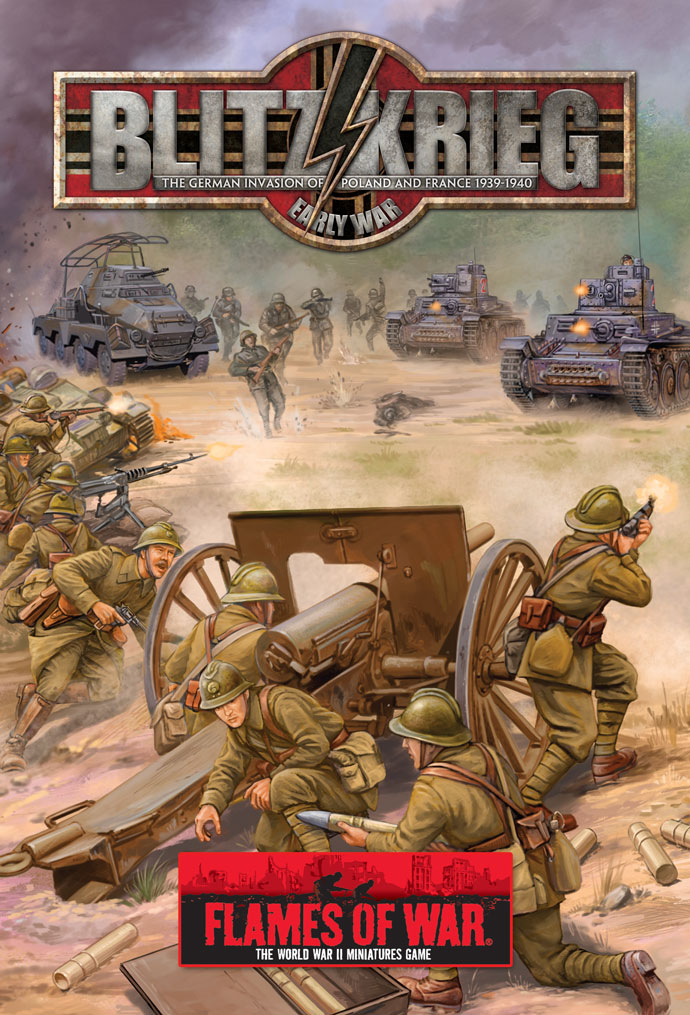 |
Poland Defeated
By 5 September 1939, after five days of war, the plans of both sides were falling apart. Marshal Rydz-Śmigły’s plan was to avoid decisive battles, buying time until Britain and France’s intervention forced Germany to pull troops out of Poland. However, Poland’s border defences had collapsed and a full-scale retreat to a new defensive line behind the Vistula River was under way. Worse, the retreating infantry divisions were being overtaken by the fast-moving German armoured spearheads, making a stand on the Vistula look more and more difficult. In addition, the German General Guderian’s armoured corps was already on the road to Warsaw and there was little to stop it short of the capital.
On the German side, Field Marshal von Brauchitsch
was concerned. The
Polish Army was not standing to fight. Instead it was escaping the
planned encirclement west of the Vistula. To destroy the Poles would
require a deeper encirclement into eastern Poland. This however,
would
commit Germany’s armoured forces at the end of a long supply line far
from Germany’s borders. If France attacked, it would be difficult to
bring them back to Germany and then pit them against France to defend
Germany’s western borders. With the French reaction as yet unknown,
this
was a risk he could not take.
|
The British and French had declared war on 3 September, but neither had any plans for an attack on Germany. Britain’s Army was tiny, making it subordinate to the French in any land battle. The French were convinced that the main lesson of the First World War was that the defensive was stronger than the offensive. With this in mind, they expected the Poles to hold out for three or four months while they organised a proper offensive against Germany. Meanwhile, the French launched a limited attack in the Saar opposite the Maginot Line to bring their front line up to Germany’s West Wall fortifications. This advance began on 7 September, and halted after an advance of 5 miles (8 km) on 12 September.
|
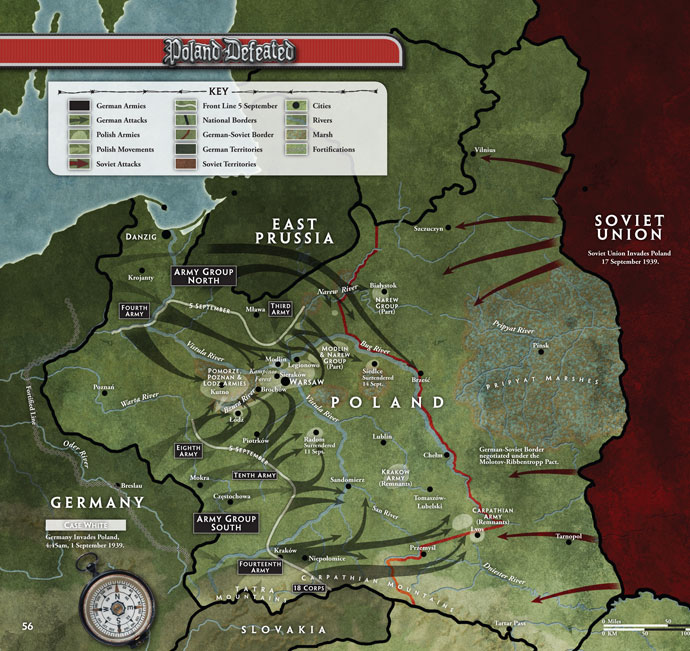 |
On the same day that the French started their attack, the lead elements of Guderian’s 19th Armoured Corps reached the outskirts of Warsaw. To avoid being surrounded in Warsaw, Rydz-Śmigły evacuated his headquarters to Brześć. Unfortunately, this put him out of touch with his armies at a critical time. He did however, order General Kutrzeba’s Poznań Army to attack southwards into the flank of the advancing German Eighth Army. The attack was to be carried out as soon as possible to relieve the pressure on the retreating Łódź Army. Unable to wait for assistance from the Pomorze Army, the Poznań Army attacked along the Bzura River on 9 September. Initially the attack went well, routing two German divisions and capturing over 1500 prisoners.
|
While the Eighth Army struggled to withstand the Polish onslaught, the German commander of Army Group South, Field Marshal von Rundstedt, saw the opportunity to bring on the decisive battle the Poles had been seeking to avoid. Guderian was ordered to turn west from Warsaw and encircle the Poles, blocking the route to Warsaw. Every available German division was thrown into the battle and by 11 September the Polish offensive had been blocked. The remains of the three Polish Armies could muster just nine infantry divisions and two cavalry brigades, and they now faced two Panzer divisions, three light divisions, and fourteen infantry divisions.
|
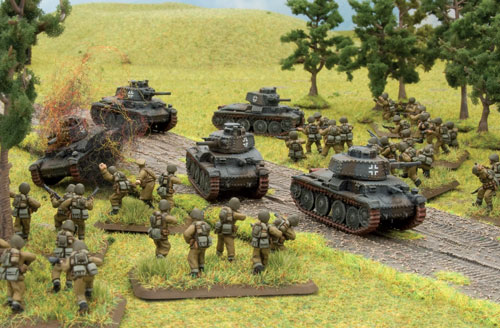 |
General Kutrzeba ignored orders to attempt to
break out towards Radom through the main German force, and took
the more realistic route of breaking out eastward towards Warsaw. Only
the two cavalry brigades and two infantry divisions managed to break out
through the Kampinos Forest before the remaining forces in the Bzura
pocket were destroyed on 18 September. By 21 September over 120,000
Polish troops had been captured. |
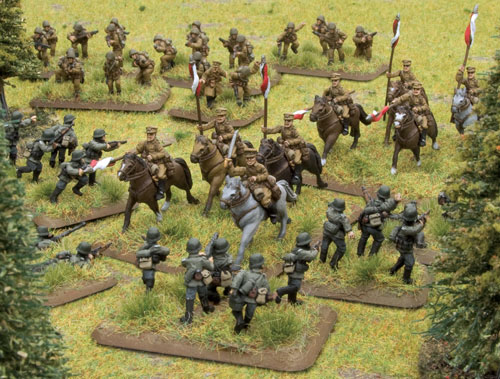 |
The Bzura counteroffensive drew off Guderian’s tanks and gave Warsaw an additional week to prepare for what must inevitably come. Two new armies, the Lublin and Warsaw Armies were formed from reserves, and defences constructed around the city. The German Third Army attacked Warsaw from the north on 15 September, but made little headway. It wasn’t until 22 September that the forces occupied by the Bzura fighting completed encircling the city in the south. The first attack on 23 September, supported by a thousand artillery pieces, was repulsed. |
| On 25 September, ‘Black Monday’ the German Air
Force bombed Warsaw with
1200 aircraft (repeated four years later by the RAF in their ‘Thousand
Bomber Raids’ on Germany). The raid left much of the city burning, but
inaccurate bombing also caused extensive casualties in Third Army to the
north. This and other air attacks on Poland used up half of the German
Air Force’s entire prewar stockpile of bombs. |
The Germans attacked again capturing key Polish
fortifications on 26
September. On 28 September Warsaw surrendered, putting another 140,000
Polish troops into captivity.
By this time events elsewhere had made continued Polish resistance impossible. On 17 September the Soviet Union invaded Poland from the east, eager to seize the share of the spoils promised by Germany in the Molotov-Ribbentropp Pact. With the Polish Army fighting in the west of the country, they faced little opposition.
|
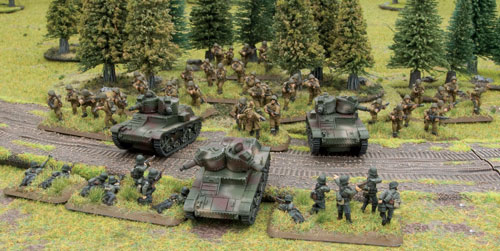 |
| Faced with the impossibility of forming a new
front against the Germans, Rydz-Śmigły ordered the remaining Polish
field armies to break out southwards to Romania where they could be
evacuated to France to continue the war. The Kraków Army spearheaded its
thrust with the Warsaw Armoured-Mechanised Brigade and the 1st Tank
Battalion, leading to the biggest tank battle of the war at Tomaszów-
Lubelski between 18 and 20 September. The German 4th Light and 2nd
Panzer Divisions blocked the thrust isolating Lvov. Polish forces
continued to fight their way towards the Romanian border until 6
October, but the Polish campaign was largely over. |
Want To Know More About Blitzkrieg?
Over the past few months we have added a massive range of articles
about Blitzkrieg to the website, to make it easier for people to find a
specific article we have put together this handy place.
Find out more about Blitzkrieg and Early-war here...
|
Last Updated On Friday, October 1, 2010 by Blake at Battlefront
|
|
|